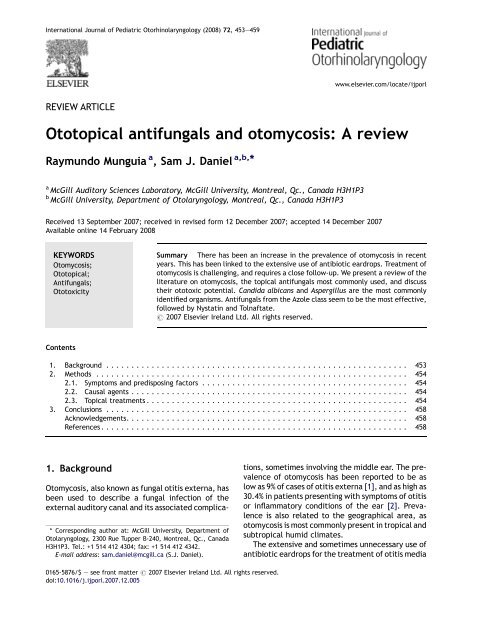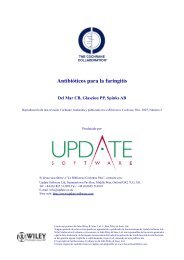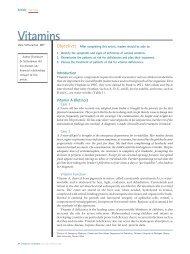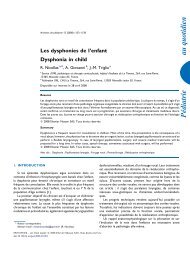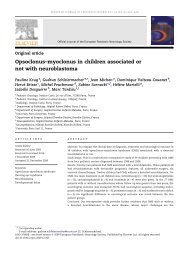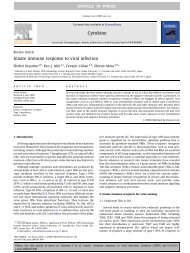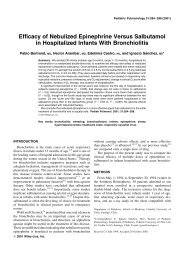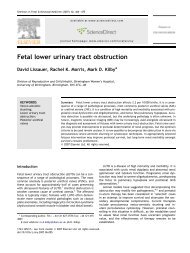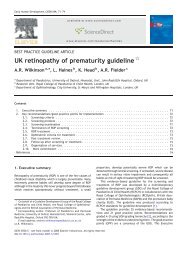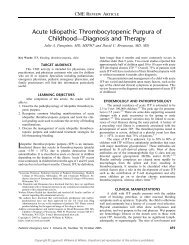Ototopical antifungals and otomycosis: A review - sepeap
Ototopical antifungals and otomycosis: A review - sepeap
Ototopical antifungals and otomycosis: A review - sepeap
Create successful ePaper yourself
Turn your PDF publications into a flip-book with our unique Google optimized e-Paper software.
International Journal of Pediatric Otorhinolaryngology (2008) 72, 453—459<br />
www.elsevier.com/locate/ijporl<br />
REVIEW ARTICLE<br />
<strong>Ototopical</strong> <strong>antifungals</strong> <strong>and</strong> <strong>otomycosis</strong>: A <strong>review</strong><br />
Raymundo Munguia a , Sam J. Daniel a,b, *<br />
a McGill Auditory Sciences Laboratory, McGill University, Montreal, Qc., Canada H3H1P3<br />
b McGill University, Department of Otolaryngology, Montreal, Qc., Canada H3H1P3<br />
Received 13 September 2007; received in revised form 12 December 2007; accepted 14 December 2007<br />
Available online 14 February 2008<br />
KEYWORDS<br />
Otomycosis;<br />
<strong>Ototopical</strong>;<br />
Antifungals;<br />
Ototoxicity<br />
Summary There has been an increase in the prevalence of <strong>otomycosis</strong> in recent<br />
years. This has been linked to the extensive use of antibiotic eardrops. Treatment of<br />
<strong>otomycosis</strong> is challenging, <strong>and</strong> requires a close follow-up. We present a <strong>review</strong> of the<br />
literature on <strong>otomycosis</strong>, the topical <strong>antifungals</strong> most commonly used, <strong>and</strong> discuss<br />
their ototoxic potential. C<strong>and</strong>ida albicans <strong>and</strong> Aspergillus are the most commonly<br />
identified organisms. Antifungals from the Azole class seem to be the most effective,<br />
followed by Nystatin <strong>and</strong> Tolnaftate.<br />
# 2007 Elsevier Irel<strong>and</strong> Ltd. All rights reserved.<br />
Contents<br />
1. Background . . . . . . . . . . . . . . . . . . . . . . . . . . . . . . . . . . . . . . . . . . . . . . . . . . . . . . . . . . . . 453<br />
2. Methods . . . . . . . . . . . . . . . . . . . . . . . . . . . . . . . . . . . . . . . . . . . . . . . . . . . . . . . . . . . . . . 454<br />
2.1. Symptoms <strong>and</strong> predisposing factors . . . . . . . . . . . . . . . . . . . . . . . . . . . . . . . . . . . . . . . . . 454<br />
2.2. Causal agents . . . . . . . . . . . . . . . . . . . . . . . . . . . . . . . . . . . . . . . . . . . . . . . . . . . . . . . 454<br />
2.3. Topical treatments . . . . . . . . . . . . . . . . . . . . . . . . . . . . . . . . . . . . . . . . . . . . . . . . . . . . 454<br />
3. Conclusions . . . . . . . . . . . . . . . . . . . . . . . . . . . . . . . . . . . . . . . . . . . . . . . . . . . . . . . . . . . . 458<br />
Acknowledgements. . . . . . . . . . . . . . . . . . . . . . . . . . . . . . . . . . . . . . . . . . . . . . . . . . . . . . . . 458<br />
References . . . . . . . . . . . . . . . . . . . . . . . . . . . . . . . . . . . . . . . . . . . . . . . . . . . . . . . . . . . . . 458<br />
1. Background<br />
* Corresponding author at: McGill University, Department of<br />
Otolaryngology, 2300 Rue Tupper B-240, Montreal, Qc., Canada<br />
H3H1P3. Tel.: +1 514 412 4304; fax: +1 514 412 4342.<br />
E-mail address: sam.daniel@mcgill.ca (S.J. Daniel).<br />
Otomycosis, also known as fungal otitis externa, has<br />
been used to describe a fungal infection of the<br />
external auditory canal <strong>and</strong> its associated complications,<br />
sometimes involving the middle ear. The prevalence<br />
of <strong>otomycosis</strong> has been reported to be as<br />
low as 9% of cases of otitis externa [1], <strong>and</strong> as high as<br />
30.4% in patients presenting with symptoms of otitis<br />
or inflammatory conditions of the ear [2]. Prevalence<br />
is also related to the geographical area, as<br />
<strong>otomycosis</strong> is most commonly present in tropical <strong>and</strong><br />
subtropical humid climates.<br />
The extensive <strong>and</strong> sometimes unnecessary use of<br />
antibiotic eardrops for the treatment of otitis media<br />
0165-5876/$ — see front matter # 2007 Elsevier Irel<strong>and</strong> Ltd. All rights reserved.<br />
doi:10.1016/j.ijporl.2007.12.005
454 R. Munguia, S.J. Daniel<br />
<strong>and</strong> otitis externa has been linked to the important<br />
increase in the prevalence of <strong>otomycosis</strong>. Secondary<br />
overgrowth of fungi is a well-known <strong>and</strong> recognized<br />
complication of the use of broad-spectrum antibiotics<br />
like quinolones [3].<br />
To date, there are four main classes of drugs for<br />
the treatment of fungal infections: polyenes, triazoles,<br />
nucleoside analogues, <strong>and</strong> echinoc<strong>and</strong>ins.<br />
The polyenes family includes amphotericin B <strong>and</strong><br />
nystatin. The triazoles family, better known as<br />
azoles includes: fluconazole, clotrimazole <strong>and</strong> miconazole.<br />
The mechanism of action of the polyenes<br />
<strong>and</strong> azole families involves an essential chemical<br />
component called ergosterol found in the fungal cell<br />
membrane. The drug binds to ergosterol <strong>and</strong> creates<br />
a polar pore in the fungal membranes. This causes<br />
ions (predominantly K + <strong>and</strong> H + ) <strong>and</strong> other molecules<br />
to leak out of the cell, leading to its death. The<br />
nucleoside analogues such as flucytosine work by<br />
interfering with nucleotide synthesis; a key step in<br />
cell energy production, metabolism, <strong>and</strong> signaling.<br />
Finally, the echinoc<strong>and</strong>ins are a novel class of antifungal<br />
agents. Their mechanism of action involves<br />
interference with cell wall biosynthesis. Their use in<br />
<strong>otomycosis</strong> has not been reported.<br />
2. Methods<br />
We performed a MEDLINE search for <strong>otomycosis</strong>related<br />
articles published between January 1951<br />
<strong>and</strong> March 2007. The resulting set of 576 articles<br />
was then restricted to those using topical <strong>antifungals</strong>.<br />
Electronic search with ‘‘topical antimycotic OR<br />
<strong>otomycosis</strong> OR antifungal drops OR antifungal eardrops’’<br />
identified 96 studies, of which 18 were<br />
considered appropriate for <strong>review</strong>. Selected articles<br />
had to specify the number of patients presenting<br />
with <strong>otomycosis</strong>, the topical medication used, <strong>and</strong><br />
the efficacy of the treatment. Reviewing individual<br />
cited references identified additional studies.<br />
We present in this article a summary of the data<br />
in the literature with regards to the topical treatment<br />
of <strong>otomycosis</strong>, the treatment efficacy, <strong>and</strong> the<br />
risk of ototoxicity.<br />
2.1. Symptoms <strong>and</strong> predisposing factors<br />
The most prominent symptoms present at the time<br />
of diagnosis were: otalgia, otorrhea, hearing loss,<br />
aural fullness, pruritus, <strong>and</strong> tinnitus [1,2,4]. Very<br />
often, fungal external ear infections manifest only<br />
in the presence of predisposing factors. Some identified<br />
culprits include humid climate, presence of<br />
cerumen acting as a support for fungal growth,<br />
configuration of the ear canal, weak immune function,<br />
diabetes, increased use of ototopical antibiotics,<br />
<strong>and</strong> prolonged use of broad-spectrum<br />
antibiotics such as fluoroquinolones. Other factors<br />
that predispose patients to <strong>otomycosis</strong> include:<br />
pregnancy, use of systemic steroids, presence of<br />
open mastoid cavities, hearing aids with occlusive<br />
molds, trauma, <strong>and</strong> bacterial infections. Several<br />
recent articles have also established the potential<br />
risk of autoinoculation of the ear canal by patients<br />
suffering of dermatomycoses [1,5].<br />
2.2. Causal agents<br />
Many species of fungi have been identified as the<br />
cause of <strong>otomycosis</strong> in the literature <strong>review</strong>ed.<br />
These are listed in Table 1 along with the antifungal<br />
agent utilized for each study. Aspergillus niger <strong>and</strong><br />
C<strong>and</strong>ida albicans are the most common causative<br />
agents of <strong>otomycosis</strong>. Aspergillus is considered the<br />
predominant causal organism in tropical <strong>and</strong> subtropical<br />
regions [6]. Aspergillus niger is the most<br />
commonly described agent in the literature [7,8].<br />
Many authors believe that it is important to<br />
identify the causal agent of <strong>otomycosis</strong> in order to<br />
use the appropriate treatment. It is also recommended<br />
that the antimycotic treatment chosen<br />
should be based on the susceptibility of the identified<br />
species [9,10]. However, others believe that the<br />
most important therapeutic strategy is to select a<br />
specific treatment for <strong>otomycosis</strong> based on the<br />
efficacy <strong>and</strong> characteristics of the drug regardless<br />
of the causal agent [11,12].<br />
2.3. Topical treatments<br />
To date there is no FDA approved antifungal otic<br />
preparation for the treatment of <strong>otomycosis</strong>. Many<br />
agents with various antimycotic properties have<br />
been used, <strong>and</strong> clinicians have struggled to identify<br />
the most effective agent to treat this condition.<br />
Antifungal agents typically reach some popularity<br />
for a short period of time, until non-desirable side<br />
effects are identified or until a new medication<br />
appears on the market. However, the use of few<br />
topical <strong>antifungals</strong> has persisted throughout time,<br />
including Nystatin <strong>and</strong> the azoles family. In addition<br />
to topical therapy, the <strong>review</strong>ed literature emphasized<br />
the importance of aural hygiene in the treatment<br />
of <strong>otomycosis</strong>, as intuitively ototopical<br />
medications work best following cleaning of secretions<br />
<strong>and</strong> debris [1,13].<br />
Table 2 summarizes the studies using topical<br />
antifungal agents, the dosage utilized, <strong>and</strong> the<br />
efficacy of treatment.<br />
Azoles are synthetic agents that reduce the concentration<br />
of ergosterol, an essential sterol in the
<strong>Ototopical</strong> <strong>antifungals</strong> <strong>and</strong> <strong>otomycosis</strong> 455<br />
Table 1 Otomycosis: description of the most common causal agents <strong>and</strong> treatment<br />
Causal agent Treatment Author<br />
Aspergillus (species not specified) Clotrimazole Ologe <strong>and</strong> Nwabuisi [17]<br />
Bassiouny et al. [10]<br />
Ketoconazole Nong et al. [19]<br />
Ho et al. [1]<br />
Itraconazole Nong et al. [19]<br />
Clotrimazole Schrader (2003)<br />
Aspergillus flavus Itraconazole, terbinafide Karaarslan et al. [24]<br />
Aspergillus fumigatus Miconazole Dyckhoff et al. [21]<br />
Amphotericin B Kintzel et al. [26]<br />
Acetic acid Jackman et al. [3]<br />
Clotrimazole Jackman et al. [3]<br />
Martin et al. [13]<br />
Tolnaftate Martin et al. [13]<br />
Aspergillus niger Borneol Chang <strong>and</strong> Li [7]<br />
Tolnaftate Damato [30]<br />
Ciclopiroxolamine, boric acid del Palacio et al. [37]<br />
Itraconazole Hoshino <strong>and</strong> Matsumoto [8]<br />
Mercurochrome Mgbor <strong>and</strong> Gugnani [4]<br />
Mishra et al. [32]<br />
Boric acid Ozcan et al. [5]<br />
Clotrimazole Pradhan et al. [15]<br />
5-Fluorocytosine Than et al. [38]<br />
Itraconazole, terbinafide Karaarslan et al. [24]<br />
Fluconazole Kurnatowski <strong>and</strong> Filipiak [2]<br />
Amphotericin B Ette et al. [27]<br />
Thimerosal Tisner et al. [31]<br />
Aspergillus terreus Lanoconazole Egami et al. [14]<br />
C<strong>and</strong>ida albicans Ketoconazole Cohen <strong>and</strong> Thompson [20]<br />
Ho et al. [1]<br />
Thimerosal Tisner et al. [31]<br />
Amphotericin B Ette et al. [27]<br />
O’Day (2004)<br />
Clotrimazole Jhadav (2003)<br />
Schrader (2003)<br />
Bassiouny et al. [10]<br />
Ologe <strong>and</strong> Nwabuisi [17]<br />
Jackman et al. [3]<br />
Martin et al. [13]<br />
Itraconazole Nong et al. [19]<br />
Fluconazole Kurnatowski <strong>and</strong> Filipiak [2]<br />
Tolnaftate Martin et al. [13]<br />
Acetic acid Jackman et al. [3]<br />
C<strong>and</strong>ida parapsilosis Clotrimazole, tolnaftate Martin et al. [13]<br />
Fluconazole Kurnatowski et al. [2]<br />
Scedosporium apiospermum Clotrimazole Bhally et al. [16]<br />
Scopulariopsis brevicaulis Nystatin Besbes et al. [25]<br />
normal cytoplasmic membrane. They are a class of<br />
five-membered nitrogen heterocyclic ring compounds<br />
containing at least one other noncarbon<br />
atom, nitrogen, sulfur or oxygen [14]. Clotrimazole<br />
is the most widely used topical azole [15,16]. It<br />
appears to be one of the most effective agents<br />
for the management of <strong>otomycosis</strong>, with a reported<br />
rate of effectiveness that varies from 95% to 100% in<br />
most studies [6,10] with the exception of one study<br />
reporting a lower efficacy rate of 50% [3]. Clotrimazole<br />
has an antibacterial effect, <strong>and</strong> this is an<br />
added advantage when treating mixed bacterial—
Table 2 Otomycosis: topical treatment efficacy represented in percentage<br />
Author Study design Antifungal Posology Number of<br />
patients<br />
Jadhav et al. [6] Prospective Clotrimazole 1% solution 4 drops tid 1 month 79 100<br />
Piantoni et al. [23] Prospective Bifonazole 1% solution, once a day 4—15 days 23 100<br />
Nong et al. [19] R<strong>and</strong>omized prospective Miconazole Once a day 2 weeks 110 97.6<br />
Ketoconazole Once a day 2 weeks 97.5<br />
Clotrimazole Once a day 2 weeks 90<br />
Thymol alcohol Three times per day for 2 weeks 80<br />
Ologe <strong>and</strong> Nwabuisi [17] Prospective Clotrimazole 1% cream once a day 2 weeks 141 96<br />
Kley [18] Prospective Clotrimazole 0.25 mg/ml once a day 8—12 days 39 94.8<br />
Tisner et al. [31] Prospective Thimerosal Not reported 152 93.4<br />
Than et al. [38] Prospective 5-Fluorocytosine 10% ointment 7—10 days 189 90<br />
Ho et al. [1] Retrospective Cresylate otic Three times per day 1—3 weeks 51 86<br />
Ketoconazole otic 1—3 cc one application 1 week 48 95<br />
Aluminium acetate otic 0.5% solution 1—3 weeks 18 86<br />
Kurnatowski et al. [2] Prospective Fluconazole 0.2% solution/three times per day 21 days 96 89.4<br />
Mgbor <strong>and</strong> Gugnani [4] R<strong>and</strong>omized prospective Locacorten-vioform 1% solution every other day 7—10 days 23 66.6<br />
Mercurochrome 1% solution every other day 7—10 days 23 95.8<br />
Clotrimazole 1% solution every other day 7—10 days 24 75<br />
del Palacio et al. [37] R<strong>and</strong>omized prospective Cyclopirox olamine 11% cream 1 week 20 80<br />
Cyclopirox olamine 1% solution 1 week 20 95<br />
Boric acid 1 week 40 72.5<br />
Ozcan et al. [5] Prospective Boric acid 4% solution in alcohol 87 77<br />
Cohen <strong>and</strong> Thompson [20] Prospective Ketoconazole Not reported 9 100<br />
Jackman et al. [3] Retrospective Acetic acid otic Not reported 15 40<br />
Clotrimazole 8 50<br />
Nystatin 2 50<br />
Aluminium acetate otic 1 0<br />
Bhally et al. [16] Case report Clotrimazole 0.25 mg/ml 1 100<br />
Mishra et al. [32] Case report Mercurochrome 1% solution 1 100<br />
Dyckhoff et al. [21] Review Miconazole 0.25% solution — —<br />
Bassiouny et al. [10] In vitro Clotrimazole otic 01—4 mg/ml — 100<br />
Econazole 1% solution — 100<br />
Miconazole 0.1—4 mg/ml — 90<br />
Cyclopirox olamine otic Not reported — 57<br />
Egami et al. [14] In vitro Lanoconazole 0.1 mg/ml — 100<br />
Efficacy<br />
(%)<br />
456 R. Munguia, S.J. Daniel
<strong>Ototopical</strong> <strong>antifungals</strong> <strong>and</strong> <strong>otomycosis</strong> 457<br />
fungal infections. It is considered free of ototoxic<br />
effects [17,18]. There are no reports of clinical<br />
evidence of clotrimazole ototoxicity. Clotrimazole<br />
is available as a powder, a lotion, <strong>and</strong> a solution.<br />
Ketoconazole <strong>and</strong> fluconazole are azole antifungal<br />
agents that have a broad spectrum of activity.<br />
This family of chemical components is effective in<br />
treating the most common etiological agents of<br />
<strong>otomycosis</strong>. Ketoconazole has shown an efficacy<br />
of 95—100% in vitro against Aspergillus species<br />
<strong>and</strong> C<strong>and</strong>ida albicans; it is available as a 2% cream.<br />
[1,19,20]. Topical fluconazole has been reported<br />
effective in 90% of cases in several series. Fluconazole<br />
suspension is available with either 350 mg or<br />
1400 mg of fluconazole. After reconstitution with<br />
24 ml of distilled water or purified water (USP), each<br />
Table 3 Otomycosis treatment <strong>and</strong> risk of ototoxicity<br />
Antifungal Tested for ototoxicity Author<br />
5-fluorocytosine Not tested Than et al. [38]<br />
Acetic acid otic Ototoxic Jackman et al. [3]<br />
Jinn et al. [36]<br />
Aluminium acetate otic Non ototoxic Ho et al. [1]<br />
Jackman et al. [3]<br />
Amphotericin B Not tested Nong et al. [19]<br />
Bifonazole Not tested Piantoni et al. [23]<br />
Boric Acid Ototoxic del Palacio et al. [37]<br />
Ozcan et al. [5]<br />
Clotrimazole Non ototoxic Bhally et al. [16]<br />
Jackman et al. [3]<br />
Tom [29]<br />
Mgbor <strong>and</strong> Gugnani [4]<br />
Ologe <strong>and</strong> Nwabuisi [17]<br />
Bassiouny et al. [10]<br />
Jadhav et al. [6]<br />
Cresylate otic Ototoxic Ho et al. [1]<br />
Cyclopirox olamine 1% otic Not tested Bassiouny et al. [10]<br />
del Palacio et al. [37]<br />
Cyclopirox olamine 11% otic Not tested del Palacio et al. [37]<br />
Econazole Not tested Bassiouny et al. [10]<br />
Fluconazole Non ototoxic Kurnatowski et al. [2]<br />
Nong et al. [19]<br />
Itraconazole Not tested Nong et al. [19]<br />
Ketoconazole Non ototoxic Cohen <strong>and</strong> Thompson [20]<br />
Nong et al. [19]<br />
Ho et al. [1]<br />
Lanoconazole Not tested Egami et al. [14]<br />
Locacorten-vioform Ototoxic Mgbor <strong>and</strong> Gugnani [4]<br />
Mercurochrome 1% Non ototoxic (FDA banned) Mgbor <strong>and</strong> Gugnani [4]<br />
Mishra et al. [32]<br />
Miconazole Non ototoxic Bassiouny et al. [10]<br />
Dyckhoff et al. [21]<br />
Nystatin Not tested Jackman et al. [3]<br />
Gentian Violet Ototoxic Tom [29]<br />
Sp<strong>and</strong>ow [35]<br />
Thimerosal Not tested Tisner et al. [31]<br />
The bolded text refers to drugs that have been classified in the literature as non-ototoxic (safe). The italic text refers to drug that<br />
have been classified as ototoxic (non-safe).
458 R. Munguia, S.J. Daniel<br />
ml of reconstituted suspension contains 10 mg or<br />
40 mg of fluconazole [2,13]. Miconazole cream 2%<br />
has also demonstrated an efficacy rate of 90%<br />
[10,21]. Bifonazole is an antifungal agent that was<br />
commonly used in the 1980s. The antifungal potency<br />
of bifonazole 1% solution has been reported to be<br />
similar to that of clotrimazole <strong>and</strong> miconazole;<br />
however, it varies from species to species. Bifonazole<br />
<strong>and</strong> derivatives inhibited the growth of most<br />
fungi with an efficacy of up to 100% [22,23].<br />
Nystatin is a polyene macrolide antibiotic that<br />
inhibits sterol synthesis in the cytoplasmic membrane<br />
[24]. Many molds <strong>and</strong> yeasts are sensitive to<br />
nystatin, including C<strong>and</strong>ida species. A major advantage<br />
of nystatin is the fact that it is not absorbed<br />
across intact skin. Nystatin is not available as an otic<br />
preparation; however it can be prepared as a solution<br />
or a suspension for the treatment of <strong>otomycosis</strong>.<br />
Nystatin can be administered as a cream, an<br />
ointment, or a powder. Reported efficacy rates vary<br />
from 50% to 80% [3,25].<br />
Amphotericin B is a member of the polyenes<br />
family. It has been replaced by safer agents in most<br />
cases but is still used, despite its side effects, for<br />
life-threatening fungal infections. Nong in 1999<br />
reported that Aspergillus <strong>and</strong> C<strong>and</strong>ida albicans were<br />
sensitive to the use amphotericin B as demonstrated<br />
in antifungal susceptibility tests [19,26,27].<br />
Tolnaftate acts by distorting hyphae <strong>and</strong> inhibiting<br />
the mycelial growth of susceptible fungi that<br />
cause skin infections, including tinea pedis (athlete’s<br />
foot), tinea cruris (jock itch), <strong>and</strong> ringwormit.<br />
It has been recommended in refractory cases of<br />
<strong>otomycosis</strong>, <strong>and</strong> was shown to be non-ototoxic<br />
[28,29]. Tolnaftate is available as a 1% solution that<br />
can be easily instilled into the ear [30].<br />
In recent years, there have been attempts to use<br />
Mercurochrome, a well-known topical antiseptic, to<br />
treat <strong>otomycosis</strong>. Along with merthiolate (thimerosal),<br />
mercurochrome is no longer approved by the<br />
FDA due to the fact that it contains mercury. Tisner<br />
in 1995 reported an efficacy of 93.4% with the use of<br />
thimerosal (merthiolate) for the treatment of <strong>otomycosis</strong><br />
[31]. Mercurochrome has been used specifically<br />
for cases reported in humid environments<br />
with a reported efficacy rate between 95.8% <strong>and</strong><br />
100% [32,4].<br />
Gentian Violet is typically prepared as a weak<br />
(e.g. 1%) solution in water. It has been used since the<br />
1940s to treat <strong>otomycosis</strong> as it is an aniline dye with<br />
antiseptic, anti-inflammatory, antibacterial, <strong>and</strong><br />
antifungal activity. It is still in use in some countries,<br />
<strong>and</strong> is FDA approved. Studies report an efficacy rate<br />
of up to 80%. [20,33—35].<br />
Other available topical medications for the treatment<br />
of <strong>otomycosis</strong> reported in the literature<br />
include cyclopirox olamine, boric acid, <strong>and</strong> 5-fluorocytocine<br />
[36]. Cyclopirox acts by chelating polyvalent<br />
cations (Fe 3+ or Al 3+ ) resulting in inhibition of<br />
the metal-dependent enzymes that are responsible<br />
for the degradation of peroxides within the fungal<br />
cell. Boric acid is a mild acid often used as an<br />
antiseptic, <strong>and</strong> insecticide. Boric acid can be used<br />
to treat yeast <strong>and</strong> fungal infections such as vaginal<br />
yeast infections caused by C<strong>and</strong>ida albicans. Itis<br />
also used to prevent athlete’s foot.<br />
5-Fluorocytocine (also known as flucytosine) acts<br />
penetrating fungal cells <strong>and</strong> is converted to fluorouracil,<br />
which competes with uracil interfering with<br />
fungal RNA <strong>and</strong> protein synthesis [37,5,38]. Table 3<br />
lists the ototoxicity potential for some of the <strong>antifungals</strong>.<br />
3. Conclusions<br />
Many species of fungi have been identified as a cause<br />
of <strong>otomycosis</strong> with Aspergillus niger <strong>and</strong> C<strong>and</strong>ida<br />
albicans being the most common culprits.<br />
Overall <strong>antifungals</strong> from the azoles class such as<br />
clotrimazole, fluconazole, ketoconazole <strong>and</strong> miconazole<br />
are more effective, followed by nystatin <strong>and</strong><br />
tolnaftate.<br />
Our <strong>review</strong> of the literature did not reveal any<br />
case reports of <strong>antifungals</strong> ototopical medication<br />
causing ototoxicity when used to treat <strong>otomycosis</strong><br />
with an intact tympanic membrane. Less data exists<br />
regarding the safety of the use of ototopical medications<br />
in the presence of a tympanic membrane<br />
perforation.<br />
Acknowledgements<br />
The authors wish to thank Ms Françoise Brosseau-<br />
Lapré for her assistance, <strong>and</strong> for editing the manuscript.<br />
References<br />
[1] T. Ho, J.T. Vrabec, D. Yoo, N.J. Coker, Otomycosis: clinical<br />
features <strong>and</strong> treatment implications, Otolaryngol Head Neck<br />
Surg 135 (2006) 787—791.<br />
[2] P. Kurnatowski, A. Filipiak, Otomycosis: prevalence, clinical<br />
symptoms, therapeutic procedure, Mycoses 44 (2001) 472—<br />
479.<br />
[3] A. Jackman, R. Ward, M. April, J. Bent, Topical antibiotic<br />
induced <strong>otomycosis</strong>, Int J Pediatr Otorhinolaryngol 69 (2005)<br />
857—860.<br />
[4] N. Mgbor, H.C. Gugnani, Otomycosis in Nigeria: treatment<br />
with mercurochrome, Mycoses 44 (2001) 395—397.
<strong>Ototopical</strong> <strong>antifungals</strong> <strong>and</strong> <strong>otomycosis</strong> 459<br />
[5] K.M. Ozcan, M. Ozcan, A. Karaarslan, F. Karaarslan, Otomycosis<br />
in Turkey: predisposing factors, aetiology <strong>and</strong> therapy,<br />
J Laryngol Otol 117 (2003) 39—42.<br />
[6] V.J. Jadhav, M. Pal, G.S. Mishra, Etiological significance of<br />
C<strong>and</strong>ida albicans in otitis externa, Mycopathologia 156<br />
(2003) 313—315.<br />
[7] S.P. Chang, Y.C. Li, Observation of cell ultrastructuse in<br />
suppurative otitis media treated with bosneol <strong>and</strong> application,<br />
Zhongguo Zhong Yao Za Zhi 25 (2000) 306—308.<br />
[8] T. Hoshino, M. Matsumoto, Otomycosis: subdermal growth in<br />
calcified mass, Eur Arch Otorhinolaryngol 263 (2006) 875—<br />
878.<br />
[9] R.R. Arthur, R.H. Drew, J.R. Perfect, Novel modes of antifungal<br />
drug administration, Expert Opin Investig Drugs 13<br />
(2004) 903—932.<br />
[10] A. Bassiouny, T. Kamel, M.K. Moawad, D.S. Hindawy, Broad<br />
spectrum antifungal agents in <strong>otomycosis</strong>, J Laryngol Otol<br />
100 (1986) 867—873.<br />
[11] J. Araiza, P. Canseco, A. Bonifaz, Otomycosis: clinical <strong>and</strong><br />
mycological study of 97 cases, Rev Laryngol Otol Rhinol<br />
(Bord) 127 (2006) 251—254.<br />
[12] C.C. Blyth, P. Palasanthiran, T.A. O’Brien, Antifungal therapy<br />
in children with invasive fungal infections: a systematic<br />
<strong>review</strong>, Pediatrics 119 (2007) 772—784.<br />
[13] T.J. Martin, J.E. Kerschner, V.A. Flanary, Fungal causes of<br />
otitis externa <strong>and</strong> tympanostomy tube otorrhea, Int J<br />
Pediatr Otorhinolaryngol 69 (2005) 1503—1508.<br />
[14] T. Egami, M. Noguchi, S. Ueda, Mycosis in the ear, nose <strong>and</strong><br />
throat, Nihon Ishinkin Gakkai Zasshi 44 (2003) 277—283.<br />
[15] B. Pradhan, N.R. Tuladhar, R.M. Amatya, Prevalence of<br />
<strong>otomycosis</strong> in outpatient department of otolaryngology in<br />
Tribhuvan University Teaching Hospital, Kathm<strong>and</strong>u, Nepal,<br />
Ann Otol Rhinol Laryngol 112 (2003) 384—387.<br />
[16] H.S. Bhally, C. Shields, S.Y. Lin, W.G. Merz, Otitis caused by<br />
Scedosporium apiospermum in an immunocompetent child,<br />
Int J Pediatr Otorhinolaryngol 68 (2004) 975—978.<br />
[17] F.E. Ologe, C. Nwabuisi, Treatment outcome of <strong>otomycosis</strong> in<br />
Ilorin, Nigeria, West Afr J Med 21 (2002) 34—36.<br />
[18] E. Kley, A contribution to the treatment of otomycoses<br />
(author’s transl), Laryngol Rhinol Otol 55 (1976) 765—767.<br />
[19] H. Nong, J. Li, G. Huang, D. Nong, P. Cheng, C. Yao, The<br />
observation of mycology <strong>and</strong> clinical efficacy in 325 cases<br />
with <strong>otomycosis</strong>, Lin Chuang Er Bi Yan Hou Ke Za Zhi 13<br />
(1999) 438—440.<br />
[20] S.R. Cohen, J.W. Thompson, Otitic c<strong>and</strong>idiasis in children:<br />
an evaluation of the problem <strong>and</strong> effectiveness of ketoconazole<br />
in 10 patients, Ann Otol Rhinol Laryngol 99 (1990)<br />
427—431.<br />
[21] G. Dyckhoff, T. Hoppe-Tichy, R. Kappe, A. Dietz, Antimycotic<br />
therapy in <strong>otomycosis</strong> with tympanic membrane perforation,<br />
Hno 48 (2000) 18—21.<br />
[22] H. Yamaguchi, K. Okamoto, M. Shooji, M. Morimatsu, S.<br />
Hirai, A case of adult type sialidosis with partial betagalactosidase<br />
deficiency without myoclonus, Rinsho Shinkeigaku<br />
23 (1983) 1—8.<br />
[23] S. Piantoni, S. Narne, R. Bottin, A. Solazzo, W. Bianchi, 1%<br />
bifonazole lotion in the therapy of <strong>otomycosis</strong>, Clin Ter 130<br />
(1989) 23—27.<br />
[24] A. Karaarslan, S. Arikan, M. Ozcan, K.M. Ozcan, In vitro<br />
activity of terbinafine <strong>and</strong> itraconazole against Aspergillus<br />
species isolated from <strong>otomycosis</strong>, Mycoses 47 (2004) 284—<br />
287.<br />
[25] M. Besbes, F. Makni, F. Cheikh-Rouhou, H. Sellami, K. Kharrat,<br />
A. Ayadi, Otomycosis due to Scopulariopsis brevicaulis,<br />
Rev Laryngol Otol Rhinol (Bord) 123 (2002) 77—78.<br />
[26] P.E. Kintzel, D.E. Trausch, A.L. Copfer, Otic administration of<br />
amphotericin B 0.25% in sterile water, Ann Pharmacother 28<br />
(1994) 333—335.<br />
[27] A. Ette, M. Bamba, P. Adjoua, J. Boguifo, E.E. Ette, K. Fakhry,<br />
et al., Mycoses in otorhinolaryngology. Apropos of 167 cases,<br />
Rev Laryngol Otol Rhinol (Bord) 110 (1989) 173—177.<br />
[28] R.R. Marsh, L.W. Tom, Ototoxicity of antimycotics, Otolaryngol<br />
Head Neck Surg 100 (1989) 134—136.<br />
[29] L.W. Tom, Ototoxicity of common topical antimycotic preparations,<br />
Laryngoscope 110 (2000) 509—516.<br />
[30] P.J. Damato, Therapy with tolnaftate in <strong>otomycosis</strong> due to<br />
Aspergillus niger, Minerva Med 64 (1973) 24—26.<br />
[31] J. Tisner, J. Millan, P. Rivas, I. Adiego, A. Castellote, H. Valles,<br />
Otomycosis <strong>and</strong> topical application of thimerosal: study of 152<br />
cases, Acta Otorrinolaringol Esp 46 (1995) 85—89.<br />
[32] G.S. Mishra, N. Mehta, M. Pal, Chronic bilateral <strong>otomycosis</strong><br />
caused by Aspergillus niger, Mycoses 47 (2004) 82—84.<br />
[33] K.O. Paulose, S. Al Khalifa, P. Shenoy, R.K. Sharma, Mycotic<br />
infection of the ear (<strong>otomycosis</strong>): a prospective study, J<br />
Laryngol Otol 103 (1989) 30—35.<br />
[34] T.L. Lawrence, L.W. Ayers, W.H. Saunders, Drug therapy in<br />
<strong>otomycosis</strong>: an in vitro study, Laryngoscope 88 (1978) 1755—<br />
1760.<br />
[35] O. Sp<strong>and</strong>ow, M. Anniko, A.R. Moller, The round window as<br />
access route for agents injurious to the inner ear, Am J<br />
Otolaryngol 9 (1988) 327—335.<br />
[36] T.H. Jinn, P.D. Kim, P.T. Russell, C.A. Church, E.O. John, T.T.<br />
Jung, Determination of ototoxicity of common otic drops<br />
using isolated cochlear outer hair cells, Laryngoscope 111<br />
(2001) 2105—2108.<br />
[37] A. del Palacio, M.S. Cuetara, M.J. Lopez-Suso, E. Amor, M.<br />
Garau, R<strong>and</strong>omized prospective comparative study: shortterm<br />
treatment with ciclopiroxolamine (cream <strong>and</strong> solution)<br />
versus boric acid in the treatment of <strong>otomycosis</strong>, Mycoses 45<br />
(2002) 317—328.<br />
[38] K.M. Than, K.S. Naing, M. Min, Otomycosis in Burma, <strong>and</strong> its<br />
treatment, Am J Trop Med Hyg 29 (1980) 620—623.<br />
Available online at www.sciencedirect.com


